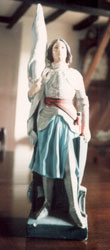
| From about 1900 Sir Hubert Miller
would spend some of his time in a villa he had in Venice. Sometimes he
would stay away from Froyle for six months of the year. But, when he returned
he would bring with him small statues of saints. These were placed in
the niches and under the eaves of the houses and cottages belonging to
the estate in Upper Froyle; and here they stand today, even though the
estate has long since been split up. As a result of this Froyle has become
known as ‘The Village of Saints’. Possibly, most people’s favourite of the 19 saints dotted around the village is St.Hubert, standing over the entrance of Old Post Office Cottage. St.Hubert, the patron saint of hunting, is shown with the stag which led to his conversion. Legend tells that while hunting in the forest on Good Friday, he came upon a stag which displayed a crucifix between its antlers and he was thus converted to a better life.  On either side of Old Post Office Cottage are houses with St.Anthony of
Padua, St.Christopher, several with St.Joseph, and a charming group of
the Holy Family adorn Jasmine and Myrtle Cottages. On either side of Old Post Office Cottage are houses with St.Anthony of
Padua, St.Christopher, several with St.Joseph, and a charming group of
the Holy Family adorn Jasmine and Myrtle Cottages.Blundens House, a 14th century timber framed building, has, in a niche over a bedroom window, the statue of St.Peter holding the ‘Keys to the Kingdom of Heaven’. Other statues include St.Katherine, with her wheel, The Virgin Mary and The Holy Shepherd. All the saints are well preserved, considering their age, but one of the most splendid must surely be St.Paul. He stands, with his sword and book, on a specially erected plinth, gracing the front of what used to be the Vicarage. When the property was sold and a new name sought for the elegant house, what could be more fitting than “St.Pauls”. One saint that visitors to the village will not see is St.Joan of Arc (right), for she is the only ‘inside saint’ as far as I know. She stands with her sword and shield in the window of a charming little cottage, where she is protected from the effects of the the weather on her painted finish. The following map shows the location of the Saints and, where possible, a picture of the appropriate Saint. |